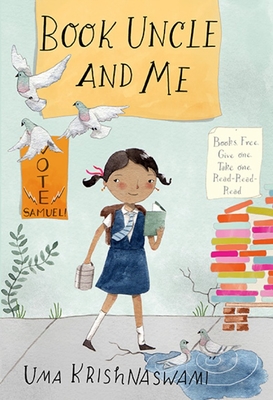Book Uncle and Me
Written by Uma Krishnaswami
Illustrated by Julliana Sweeney
Yasmin-ma, a curious, determined and courageous nine year old girl is on a mission to bring back Book Uncle, a kind
retired teacher, and his free lending library! Throughout the book, you can clearly see that she is a true leader as she
politically organizes and realizes her own agency and the power of grassroots activism. As I reflect and continue to
find meaning in this book, I appreciate how this book recognizes and gives power to youth in which they rightfully
deserve. This book digs into the reality of the main characters' community. At the end of the book, she helps enact
political change by bringing back Book Uncle. This book would be a perfect read for fourth graders because they can
recognize different issues within their community and plan for action.
This book portrays Element 4: Social Movements and Social Change. Book Uncle and Me aligns with Element 4
because the author tells our students about ways that ordinary people can and will enact change in their communities.
Even young people can get involved in democracy. Additionally, Yasmin-ma exemplifies a leader in which she was
able to even change the outcome of the election at 9 years old. Being a part of the Global majority, she was able to
overcome obstacles that the candidates running had in place. Books can change your life, and this book is a must
read !!
Book Uncle and Me Classroom Activity:
There are a variety of discussion questions and classroom activities that are provided at the end of Book Uncle and Me.
These are activities that I liked from the book being that they address the community movement that was created by
Yasmin-ma as well as taking a look at the similarities and differences of the student’s lives and the life of Yasmin-ma.
1. The teacher can prepare a Venn Diagram on post-it paper. The teacher can make a note of ten things that are most
important between the student's life and Yasmin-ma's, and ten things that are the same. We can ask students to look
at the first list. First, we can ask "Why do you think these things are so different from your life?" Then, we look at
the second list and ask "Why do you think these things are so similar?"
2. The main characters in the book try to affect change by communicating with the city's mayor.This is a good example
of community movement, and is a way to make sure your voice is heard by the people in power. As a class, discuss
any issues that you feel needs to be addressed. Some suggestions are creating a community garden, local park or
waterway that needs to be cleaned up, or creating a local park. Write to your local government about this, representing
your community's views.







